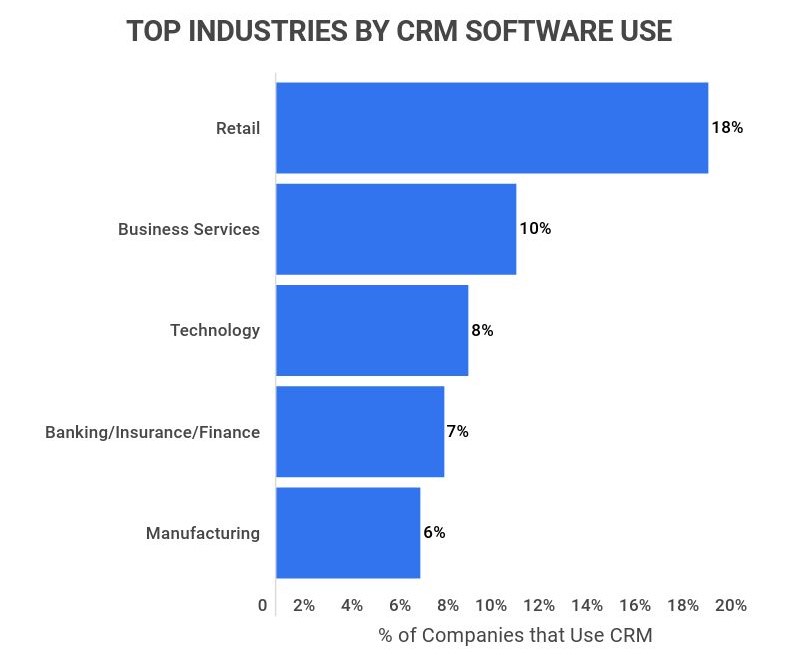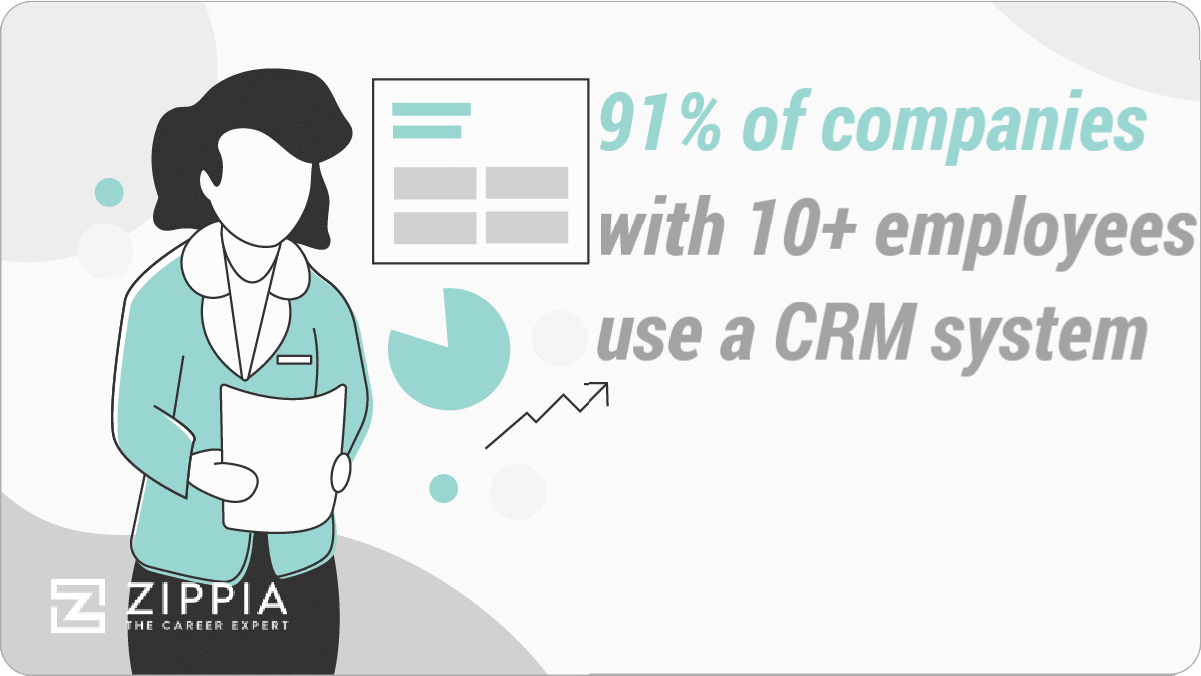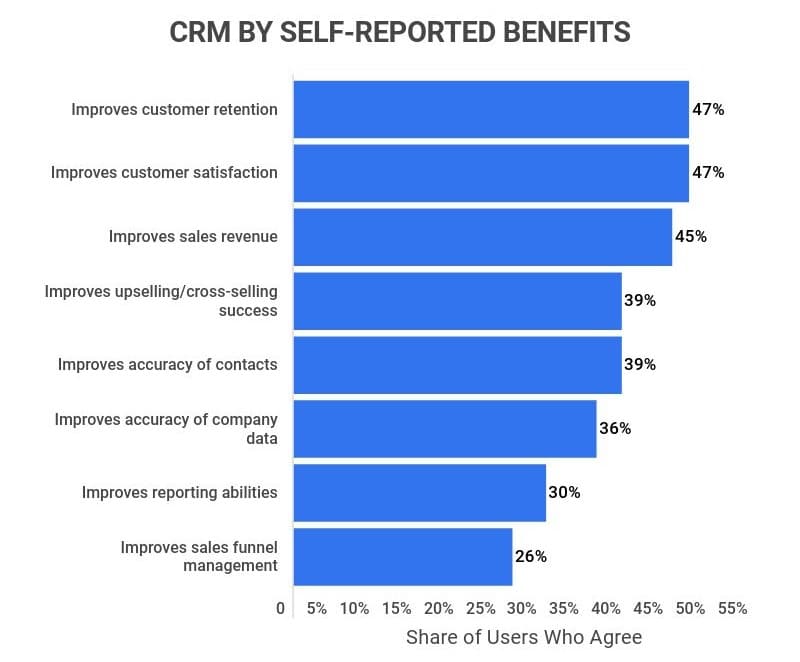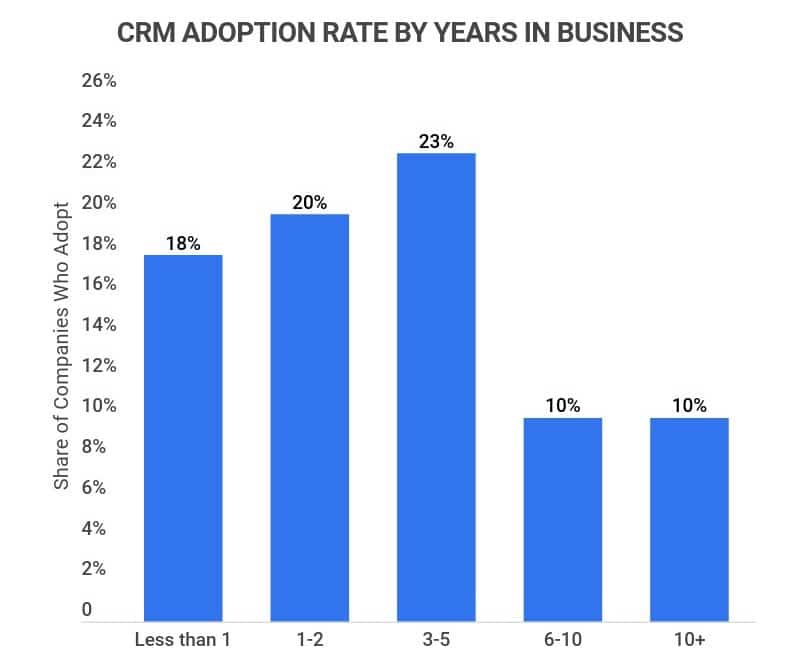- Business Metrics
- Credit Card Statistics
- Customer Retention Statistics
- Advertising Statistics
- CMS Statistics
- CRM Statistics
- Big Data Statistics
- User Experience Statistics
- Black Friday Statistics
- Website Design Statistics
- Supply Chain Statistics
- Live Chat Statistics
- App Revenue Statistics
- Blockchain Statistics
- Online Shopping Statistics
Research Summary. Customer relations management, or CRM, refers to the strategies and tools that companies use to keep track of all of their communications with their customers. These systems also usually allow companies to create better, data-backed strategies in the future. Here are some key CRM statistics:
-
91% of companies with ten or more employees use a CRM system.
-
45% of companies said their use of CRM software increased sales revenue.
-
The average ROI for CRM spending is $8.71 for every dollar spent.
-
47% of companies saw their customer retention rate increase when they started using CRM.
-
Companies that implement CRM can see a 300% increase in conversion rates.
For further analysis, we broke down the data in the following ways:
Salespeople | Benefits | Adoption | Trends

General CRM Statistics
-
Salesforce has the largest share of the CRM market, with 19.5%.
-
The CRM market is expected to earn $49.6 billion in revenue in 2025.
-
82% of companies use CRM for sales reporting and process automation.

CRM Statistics by Salespeople and Sales Teams
-
65% of salespeople who use mobile CRM meet their sales quotas as opposed to 22% who don’t use mobile CRM.
-
Companies can see a 50% sales productivity increase by using CRM.
-
Companies can cut their labor costs by 20% by using CRM.
-
Sales representatives spend 17.9% of their time on CRM.
CRM Statistics by Benefits and Challenges
-
47% of CRM users say it improves customer retention rates.
In addition, 47% say it improves customer satisfaction (which usually also leads to customer retention), 45% say it improves sales revenue, and 39% say it improves their upselling and cross-selling success.

-
30% of companies say that CRM improves their reporting abilities.
26% say that it improves their sales funnel management, and 39% and 36% say they improve the accuracy of their contacts’ and companies’ data, respectively.
-
17% of businesses say that manual data entry is their biggest challenge in using their current CRM.
Another 17% say that a lack of integration is their biggest challenge, and 16% said that their sales teams just don’t use the CRM.
Here is the breakdown of the top challenges companies face in using their CRM:
Biggest Challenge Percent of Companies Manual data entry 17% Lack of integration with other tools 17% My sales team doesn’t use it 16% Don’t know/not applicable 14% Difficult to track my sales funnel 12% Invalid of incorrect data 8% It’s too complicated to use 7% Managers don’t use it 5% Other 5% -
Less than a third of managers say that their CRM software is actually helpful in executing their companies’ strategies.
This means that while 91% of companies may have CRM systems in place, less than a third actually feel that they’re successful with their CRM systems, whether that’s because they don’t feel equipped to use it well or because the software can’t do what they need it to.
CRM Statistics by Adoption
-
65% of companies adopt CRM within five years of launching.
Here is the breakdown of when companies adopt CRM:
How Long After Founding Company Adopted CRM Share of Companies Three to five years 23% One to two years 20% Less than one year 18% Company founded before CRM 13% Six to ten years 10% More than ten years 10% Not sure 8% 
-
73% of businesses that use CRM use cloud-based CRM programs.
Just 27% of businesses have their CRM installed on their servers, the majority of which are in the hospitality, nonprofit, and banking/financial services industries. Many manufacturing and consulting organizations also prefer to house their CRMs this way.
-
The retail industry uses the most CRM software, with 18% of companies using it.
Here is the breakdown of the top industries that use CRM:
Industry Percentage of Companies That Use CRM Retail 18% Business Services 10% Technology 8% Banking/Insurance/Finance 7% Manufacturing 6% -
Business-to-consumer companies make up the largest share of CRM users at over 60% of all users.
This is followed by business-to-business companies making up about 55% of CRM users. Business-to-government, nonprofits, and other organizations each had shares of around 10% and under (in this particular survey, companies could choose more than one segment).
CRM Statistics by Trends and Projections
-
The value of the U.S. CRM market is expected to grow at a CAGR of 12% from 2022 to 2030.
In 2021, the market was valued at $21.2 billion, and in 2020, it was valued at $19.4 billion. If these estimates hold true in the future, the market will be worth more than $42 billion by 2030.
-
The average spending on CRM per employee is projected to reach $33.21 in 2027.
In 2021, companies spent an average of $18.53 per employee on CRM.
-
In 2010, the global CRM software market earned $13.93 billion in revenue.
In 2020, it earned $69 billion, which means the CRM software market saw its annual revenue nearly quintupled in just ten years. Even in the four years between 2016 and 2020, it more than doubled, growing from $33.7 billion in 2016 to $69 billion in 2020.
CRM Statistics FAQ
-
How effective is CRM software?
CRM software can be very effective. Of the companies that have implemented CRM software, 45% said they saw increased sales revenue thanks to CRM, and 47% said they saw their customer retention rates increase.
In addition, many companies can see a 300% increase in conversion rates, a 50% increase in sales productivity, and a 20% reduction in labor costs when they implement CRM.
30% of companies also say that CRM improves their reporting abilities, which saves valuable time and effort, and 26% say that CRM improves their sales funnel management.
However, the key to CRM software being effective is to choose the right one for your particular company’s needs, as less than one-third of managers say their CRM software helps them accomplish their company’s strategies.
That’s a lot of people with less-than-useful software when you consider that 91% of companies with ten or more employees have it.
-
How much money does CRM software save?
CRM software can save 20% of companies’ current labor costs. This is the rate of savings that companies who implemented this software saw in this area, in addition to a 300% increase in conversion rates, which translates to an increase in revenue.
Even though CRM software does cost companies something to have, it is worth it: The average ROI for CRM spending is $8.71 for every dollar spent, and that appears to be going up all the time.
Because CRM allows salespeople and marketing employees to streamline their processes and collect data that can be used to save time and make better decisions in the future, it’s typically very beneficial to companies bottom lines.
-
Business-to-consumer companies use CRM the most. These companies make up 60% of CRM users, the largest share of any category. Business-to-business companies aren’t far behind business-to-consumer companies, however, accounting for 55% of CRM users.
Business-to-government and nonprofits each make up 10% or less of CRM users.
The industries that use CRM the most usually fall into the business-to-consumer and business-to-business categories as well. The retail industry has the largest share of CRM users at 18% of its companies using it, followed by business services with 10% and technology with 8%.
7% of companies in the banking/insurance/finance industry use CRMs, and 6% of those in manufacturing do as well.
-
What percentage of businesses use CRM software?
91% of businesses with ten or more employees use CRM software. Many startups don’t use CRM software because it can be expensive (it costs an average of $18.53 per employee), but when they do use it and use it well, the payoff can be worth it.
By using CRM, companies can cut labor costs by 20%, can see a 300% bump in their conversion rates, and can improve their sales productivity by 50%. All of this usually adds up to an ROI of $8.71 for every dollar spent on CRM.
While this is valuable to any business, it’s especially impactful for small startups that need to maximize every penny and every person on their team.
-
How much does a CRM increase sales?
A CRM can increase sales by 300%. Companies that use CRM effectively can see their conversion rates triple as they improve their communication processes and maximize the effort that their salespeople are putting in.
In addition, companies can see a 50% sales productivity increase and a 20% labor costs decrease by using CRM.
When companies use CRMs, nearly half said they see improved customer satisfaction and retention rates and sales revenue, and over a third said they see improved success in their upselling and cross-selling success.
The key is to find a CRM tool that will meet your organization’s goals and that your sales and marketing teams will actually use, as under 30% of managers say that their CRM software helps them execute their companies’ strategies.
As for those who don’t feel it’s helpful, they say it’s because they either don’t know how to use it or the particular software can’t do what they need it to do. So, if you’re the person choosing CRM software for your company, make sure you choose one that will match your organization’s needs and then train people on how to use it.
-
The CRM market is valued at $21.2 billion. This was the U.S. CRM market’s value as of 2021, and it’s up from the $19.4 billion it was valued at in 2020.
The global CRM software market earned $69 billion in 2020, up from the $13.93 billion it earned just ten years earlier in 2010.
The U.S. CRM market is expected to continue to grow in the future with an estimated CAGR of 12% from 2022 to 2030, putting its value over $42 billion by 2030.
-
How fast is the CRM market growing?
The CRM market is growing at a CAGR of 12%. This is the estimated CAGR for the U.S. CRM market from 2022 to 2030, which would move its value from $21.2 billion in 2021 to more than $42 billion in 2030.
The global CRM software market is expanding quickly as well. In the ten years between 2010 and 2020, it saw its annual revenue increase from $13.93 billion to $69 billion – that’s an increase of almost five times.
Conclusion
CRM, or customer relations management, has been a gamechanger for many companies, increasing conversion rates by up to 300% and decreasing labor costs by up to 20%.
CRM programs allow companies to improve their reporting abilities, manage their sales funnels more effectively, and improve the accuracy of their contacts’ and companies’ data – all of which are vital to having an effective and efficient sales strategy.
However, just over 70% of managers say that their companies’ CRM programs aren’t helpful to them, whether that’s because they haven’t been trained or because the particular program they use doesn’t do what they need it to do.
Others say that their sales teams just don’t use it or that it doesn’t integrate well with their other tools – all issues that executive and CRM providers are working to solve. These challenges don’t seem to be affecting the growth of the CRM market, though, as the U.S. market is worth $21.2 billion as of 2021 and is expected to reach $42 billion in value by 2030.
References
-
Nucleus Research. “CRM Pays Back $8.71 for Every Dollar Spent.” Accessed on April 28, 2022.
-
Entrepreneur. “How CRMs Can Spark (or Continue) Fast Growth.” Accessed on April 28, 2022.
-
Statista. “Leading Vendor Market Revenue Share of Customer Relationship Management (CRM) Applications Market Worldwide From 2016 to 2020.” Accessed on April 28, 2022.
-
Statista. “Customer Relationship Management (CRM) Software Market Revenues Worldwide From 2015 to 2025.” Accessed on April 28, 2022.
-
Grand View Research. “Customer Relationship Management Market Size, Share, and Trends Analysis Report by Solution, by Deployment (On-Premis, Cloud), by Enterprise Size, by End Use, by Region, and Segment Forecasts, 2022-2030.” Accessed on April 28, 2022.
-
Slideshare. “Mobile CRM by Innoppl.” Accessed on April 28, 2022.
-
Forbes. “Why Sales Reps Spend Less Than 36% of Time Selling (And Less Than 18% in CRM).” Accessed on April 28, 2022.
-
Capterra. “CRM User Research Infographic.” Accessed on April 28, 2022.
-
HubSpot. “The State of Inbound 2016.” Accessed on April 28, 2022.
-
Destination CRM. “Tips for Maximizing CRM Investments.” Accessed on April 28, 2022.
-
Capterra. “CRM Industry User Research Report.” Accessed on April 28, 2022.
-
Statista. “Customer Relationship Management Software.” Accessed on April 28, 2022.
-
Statista. “Customer Relationship Management (CRM) Software Revenue Worldwide From 2010 to 2020.” Accessed on April 28, 2022.
- Business Metrics
- Credit Card Statistics
- Customer Retention Statistics
- Advertising Statistics
- CMS Statistics
- CRM Statistics
- Big Data Statistics
- User Experience Statistics
- Black Friday Statistics
- Website Design Statistics
- Supply Chain Statistics
- Live Chat Statistics
- App Revenue Statistics
- Blockchain Statistics
- Online Shopping Statistics





